As the most exposed part of the house, the roof system is one of the areas most prone to challenges that can directly impact performance and longevity. Among those problems, ice dams are one of the biggest. Designing roof systems to avoid ice damming is essential for preventing moisture buildup and roof failure. Consider these strategies for reducing the likelihood of ice dams.
What are Ice Dams?
Ice dams are a challenge in colder climates where snow may build up on the roof during winter months. When the snow melts—whether due to warmer temperatures during the day or warm interior air rising and heating the roof sheathing—the water runs down the shingles, and then freezes near the gutters and eaves. When this process happens consistently, ice at the roof eaves builds up, forming an ice dam that prevents water from draining.
Steep-pitched roofing materials are designed to shed water—they are not waterproof—so the resulting buildup of trapped water may eventually pass through to the sheathing and even the home interior itself, leading to rot, decay, and mold.
How to Prevent Ice Dams
Preventing ice dams, and the issues they cause, relies on a combination of proper design, innovative materials, and homeowner maintenance.
Preventing Ice Dams with Ridge Vents, Ventilated Soffits, and Insulation
Preventing ice dams starts at the design phase. Proper ventilation, via ridge vents and ventilated soffits, can help maintain more consistent temperatures in the roof system to prevent excessive freeze/thaw cycles. The National Weather Service a minimum of R-38 insulation for northern climates to prevent heat loss from the interior that can warm the sheathing and melt snow.
Using Self-Adhered Underlayment to Address Ice Dams
If ice dams do form, a self-adhered underlayment such as VaporDry SA may offer peace of mind against water build-up reaching the interior. Along with serving as the moisture control layer, VaporDry SA’s solid, continuous acrylic adhesive provides consistent nail sealing no matter where the shingles are attached, helping to prevent water from getting through. In addition, the underlayment is vapor permeable, which allows the roof sheathing to dry to the exterior if it were saturated from rising interior moisture.
Preventing Ice Dams with Regular Maintenance
Builders should educate their homeowners on the importance of cleaning debris from their eaves and gutters to eliminate problem areas where snow melt can build up and form ice dams. The National Weather Service also recommends homeowners clear snow from the roof.

VaporDry® SA Samples
GET YOUR FREE VAPORDRY® SA SAMPLES TODAY
Installing VaporDry SA Properly Around Eaves
VaporDry SA can be used for the entire roof deck, not just areas prone to ice damming, so only one product is needed.
Install VaporDry SA directly to the subfascia and up the roof about 12 inches at the eaves, as ice damming can force its way up under metal drip edges. This will protect the wood structure from water damage. Then install the metal drip edge on top of the underlayment. Finally, install the first full course of VaporDry SA to shingle overlap the drip edge and adhere to the top edge of the partial width of VaporDry SA. Cover the rest of the roof using proper sequencing to ensure water has a proper drainage path and won’t become trapped behind the underlayment.
For support in designing roof systems in northern climates using VaporDry SA, reach out to Benjamin Obdyke for a virtual training session.




